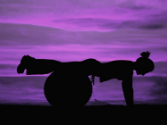 I realized long ago that I’m no Gumby. Unfortunately for way too long I have accepted that I can’t really do anything about my ability to be flexible. But that is changing. As I get older I am trying harder to change my non-Gumby status…and I am determined to become more flexible because I know that the implications are far greater than just not being able to touch to ground with my fingertips. The following is an article by Alan Tyson, a sports physical therapist and owner of Architech Sports.
I realized long ago that I’m no Gumby. Unfortunately for way too long I have accepted that I can’t really do anything about my ability to be flexible. But that is changing. As I get older I am trying harder to change my non-Gumby status…and I am determined to become more flexible because I know that the implications are far greater than just not being able to touch to ground with my fingertips. The following is an article by Alan Tyson, a sports physical therapist and owner of Architech Sports.
By Alan Tyson
Stretching is typically the most overlooked part of an exercise routine. Many people do not stretch because the results are not seen for some time. Increasing the muscle length takes time and stretching must be done on a regular basis. How many times have you exercised regularly and then took a break for a week or two because something came up or you were recovering from an injury? What did it feel like the first time you returned to the gym or sport you were playing? It was much tougher wasn’t it? Muscles will conform to the actions and stresses placed on them, whether that means becoming toned, stronger, bigger or more flexible because of training or becoming weaker or tighter because of disuse or a sedentary lifestyle.
A muscle that possesses greater range of motion passively is less likely to experience tears when used actively [it must be noted that there are some problems on the opposite end of the spectrum for people who have too much flexibility and thus excessive motion about a joint or joints, but this issue must be saved for a future discussion]. It is also important to realize that decreased flexibility in a muscle not only affects the surrounding joint(s) but also the joints above and/or below.
Many experts believe that flexibility plays a key role in maintaining healthy joints. Stretching increases tissue temperature, blood supply, and nutrient transport to the tissues and to the synovial fluid within the joint. These factors help to reduce tension and resistance in muscle tissue, promote better posture, reduce joint degradation and can decrease muscle soreness after exercise.
Reduced Risk of Low Back Pain
Flexibility in the hamstrings, quadriceps, hip flexors and other muscles that attach to the pelvis reduces stress to the low back. If one or two muscle groups are overly tight then this can create an imbalance. Take tight hip flexors, for example. If your hip flexors are overly tight they will pull on your spine and increase the lordotic curve in your low back. Imbalances such as this cause increased tensile or compressive strain on the joints and limit the joints’ total available motion. Stretching regularly promotes muscle relaxation and increased length, reducing the strain on your back.
How does flexibility affect athletic performance?
Flexibility is an integral component in speed and power development, a point that many athletes are not made to realize. Too many athletes neglect flexibility training. A BIG MISTAKE! Many sports often cause imbalances within the body. Take tennis. The same arm is used for thousands of overhead and ground strokes, over and over again. One side of the body becomes more developed and is placed under more stress than the other side. Throw poor posture into this mix and you are talking about a problem waiting to happen. The same goes for baseball, golf and basketball. Even soccer, rugby and football players will have a dominant kicking foot or throwing/holding arm or a dominant leg used for power. Stretching regularly is vital for reducing the long term risks that can create chronic injuries.
Key Points for Effective Stretching
1. Perform stretching exercises when your body is warm, ideally at the end of a workout or training session or after 5-10 minutes of light aerobic exercise to warm the muscles and improve their pliability.
2. Pay particular attention to the muscle groups that are involved most in your sport, but remember that tight muscles above or below the target area will affect performance as well.
3. Hold each stretch for 30 seconds. Initial tightness should gradually diminish as you hold the stretch. If the tightness of the stretch does not almost completely fade away then you may be stretching too aggressively.
4. Repeat each of the stretching exercises 2-3 times in succession.
5. Perform these stretching exercises at least 3 times a week. Daily is preferred. We tell our athletes to stretch every day that “ends with a “Y”.. so not tomorrow but today!
6. IF YOU FEEL ANY PAIN WHATSOEVER…STOP IMMEDIATELY!
Stretching should not be painful.





Speak Your Mind